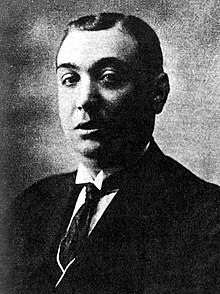Salvador Seguí
Salvador Seguí | |
|---|---|
 | |
| General Secretary of the Confederación Nacional del Trabajo | |
| In office December 1922 – 10 March 1923 | |
| Preceded by | Joan Peiró |
| Succeeded by | Manuel Adame |
| Personal details | |
| Born | Salvador Seguí i Rubinat 23 September 1887 Lleida, Spain |
| Died | 10 March 1923 (aged 35) Barcelona, Catalonia, Spain |
| Cause of death | Extrajudicial killing |
| Resting place | Montjuïc Cemetery |
| Nationality | Catalan |
| Political party | Confederación Nacional del Trabajo |
| Spouse | Teresa Muntaner |
| Part of a series on |
| Anarcho-syndicalism |
|---|
 |
Salvador Seguí i Rubinat (23 September 1887, in Lleida – 10 March 1923, in Barcelona), known as El noi del sucre ("the sugar boy" in Catalan) for his habit of eating the sugar cubes served him with his coffee, was a Catalan anarcho-syndicalist in the Confederación Nacional del Trabajo (CNT), a Spanish confederation of anarcho-syndicalist labor unions.
Biography
[edit]He is mainly remembered for playing a major role in building and organizing the workers' movement in Catalonia. He became General Secretary of the CNT in Catalonia in 1918.
While he was General Secretary in Catalonia, the CNT played a major role in the ''La Canadenca'' strike, which lasted for 44 days, which paralyzed 70% of the Catalan economy, and which led to Spain being the first country in the world to establish the 8-hour working day by law.[1] During the strike, Seguí was imprisoned, but was liberated on the last day of the strike, just in time to attend the general assembly attended by 20.000 workers which ended the strike.[2] He was the person who communicated all the achievements.[3]
Together with Ángel Pestaña, Seguí opposed the paramilitary actions advocated and carried out by other members of the CNT.[4] On 10 March 1923, while completing preparations to promote the idea of emancipation as a form of social empowerment among workers, he was assassinated by gunshot on Carrer de la Cadena, in Barcelona's Raval District, at the hands of gunmen working for the Catalan employers' organisation under protection of Catalonia's Civil Governor, Martínez Anido.[5][6] At this same shooting, another anarcho-syndicalist, Francesc Comes, known as Perones, was wounded and was to die several days later. He was buried in the Cemetery of Montjuïc, Barcelona.
He has received many tributes since his death, and a foundation has been launched in his memory, the Fundación Salvador Seguí,[7] based in Barcelona, Madrid and Valencia. In 2023, during the centennial anniversary of his assassination, many commemmorative events were organized. Several expositions were held throughout the territory.[8][9][10][11] In addition, a commemmoration was held by the Fundación Salvador Seguí, the CNT, the GGT, Solidaridad Obrera, and the Fundación Anselmo Lorenzo.[12] A square in El Raval neighborhood of Barcelona is named after him.[13]
Bibliography
[edit]- Seguí, Salvador «Noi del Sucre». Escuela de Rebeldía (Historia de un sindicalista), Ilustraciones de M. Ramos, Madrid, La Novela de Hoy (Sucesores de Rivadeneyra), 1923.
- Seguí, Salvador. Narraciones. anarco-sindicalistas de los años veinte / Salvador Seguí...[et al.], Barcelona, Icaria, 1978.
- Martí Font, Jordi (2021). ''Salvador Seguí. El colós de l'anarquisme''. Lo Diable Gros.
See also
[edit]References
[edit]- ^ Balcells, Alberto (1968). El sindicalismo en Barcelona (1916–1923). Barcelona: Nova Terra. pp. 77–78.
- ^ NacióDigital. "Cent anys del míting de les Arenes". www.naciodigital.cat (in Catalan). Retrieved 28 August 2023.
- ^ "SALVADOR SEGUÍ. EL COLÓS DE L'ANARQUISME. SEGUÍ I RUBINAT, SALVADOR. Libro en papel. 9788412204339 La Tribu Llibreria". www.latribullibreria.com (in Spanish). Retrieved 28 August 2023.
- ^ Carr, Raymond (2002). Modern Spain, 1875–1980. Oxford University Press. ISBN 0-19-280129-5.
- ^ Guérin, Daniel (2006). No Gods, No Masters: An Anthology of Anarchism. AK Press Politics. ISBN 1-904859-25-9.
- ^ Història de la cultura catalana [History of the Culture of Catalonia] (in Spanish). Edicions 62 (in Catalan). 1999.
- ^ "Fundación Salvador SeguÍ". www.fundacionssegui.org (in Spanish). 16 November 2007. Retrieved 28 August 2023.
- ^ Redacció (28 April 2023). "VÍDEO | Una exposició repassa la vida de Salvador Seguí, el Noi del Sucre, en el centenari del seu assassinat". La República (in Catalan). Retrieved 28 August 2023.
- ^ Abacus, Comunicacio (3 May 2023). "Abacus Idea produeix l'exposició 'Salvador Seguí, el noi del sucre' a partir d'una investigació de Sàpiens". Abacus Cooperativa (in Catalan). Retrieved 28 August 2023.
- ^ "Inauguració de l'exposició "Salvador Seguí, el Noi del Sucre"". Govern.cat. Retrieved 28 August 2023.
- ^ Barcelona, UAB-Universitat Autònoma de. "Exposición "A las barricadas. Anarquismo en Cataluña"". UAB Barcelona (in Spanish). Retrieved 28 August 2023.
- ^ "CGT conmemora el centenario de asesinato de Salvador Seguí en el cementerio de Montjuic junto con otras organizaciones anarcosindicalistas - CGT - Confederal". cgt.org.es (in Spanish). Retrieved 28 August 2023.
- ^ "Plaça Salvador Seguí". (barcelona-metropolitan.com). 1 October 2023. Retrieved 25 September 2023.
External links
[edit] Media related to Salvador Seguí at Wikimedia Commons
Media related to Salvador Seguí at Wikimedia Commons- Fundación Salvador Seguí (in Spanish)
- Groupe anarchiste Salvador-Segui (in French)
- 1887 births
- 1923 deaths
- People from Lleida
- Anarchists from Catalonia
- Confederación Nacional del Trabajo members
- Anarcho-syndicalists
- Inmates of Presó Model de Barcelona
- Assassinated anarchists
- Spanish syndicalists
- Assassinated trade unionists
- Assassinated Spanish people
- General secretaries of the Confederación Nacional del Trabajo
